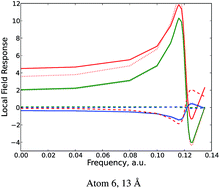Local electric field factors by a combined charge-transfer and point–dipole interaction model†
Abstract
A force-field model for the local electric field as a linear response to a frequency-dependent external electric field is presented based on a combined charge-transfer and point–dipole interaction (CT-PDI) force-field model for frequencies through the first absorption maximum. The local electric field provides a measure of the mutual interactions of the molecules with each other, as is important in problems ranging from dielectric breakdown to solvent polarization and energy transfer. It also indicates how resonant excitation of these molecules can perturb Raman scattering by a third molecule located nearby through an intensity borrowing mechanism. The CT-PDI model is a combination of a modified electronegativity equalization model including non-metallic behaviour and a point–dipole interaction model described by atomic polarizabilities which also includes the time-dependence of the atomic charges and atomic dipole moments. A parametrization of frequency-dependent polarizabilities through the first absorption maximum calculated by time-dependent density-functional theory has been extended for a set of hydrocarbon and azobenzene molecules to provide atom-type parameters for the CT-PDI model. As initial model systems, results are presented for the benzene and azobenzene dimers for the local electric field response at points between the molecules and at the atoms in the molecules. As expected, the response depends critically on the intermolecular distance between the monomers. The azobenzene dimer shows a larger local field response at the atoms in the phenyl rings compared to the benzene dimer and the response at the nitrogen atoms is larger than at the hydrogen and carbon atoms in the azobenzene dimer, which can be rationalized qualitatively by the charge and dipole contributions to the local field factor either adding up or to a large extent cancelling each other. At the absorption frequency, the largest local field factor of the benzene dimer is around 6 and for the azobenzene dimer it is around 12, respectively, at typical distances, indicating that the response may be significant.


 Please wait while we load your content...
Please wait while we load your content...